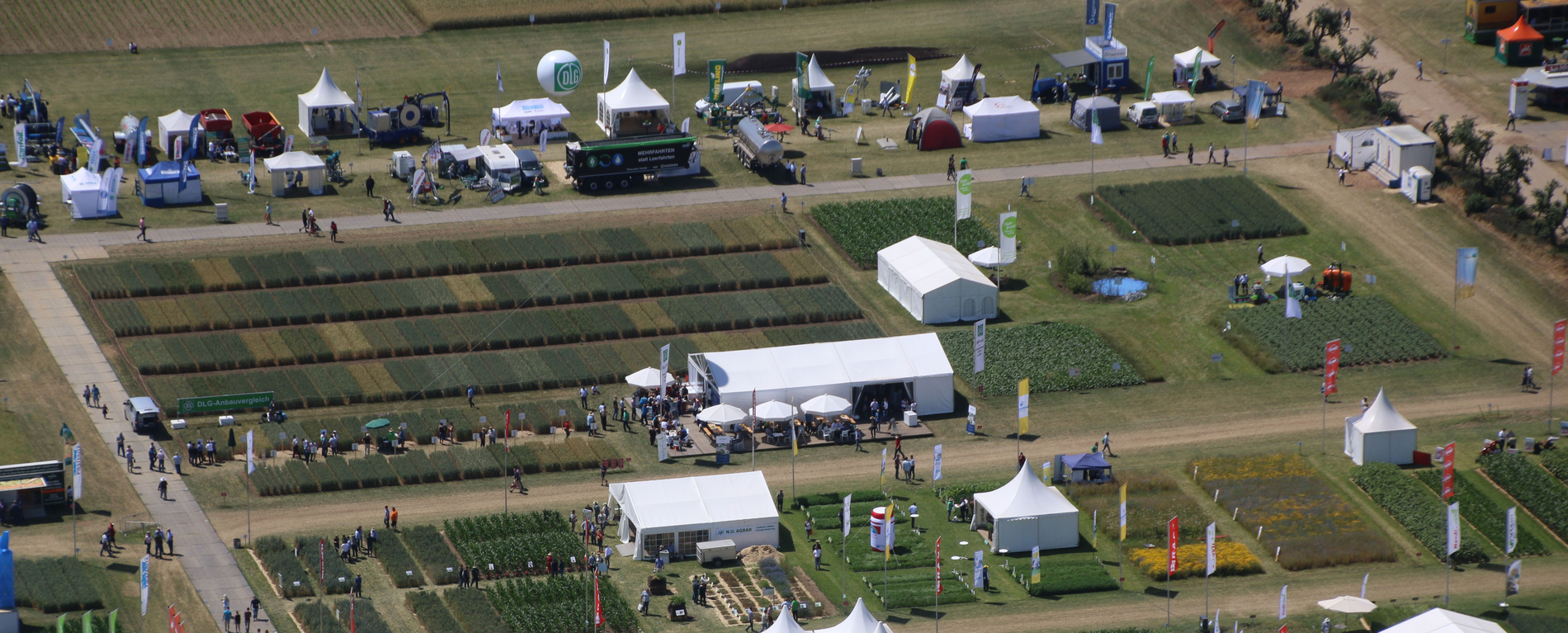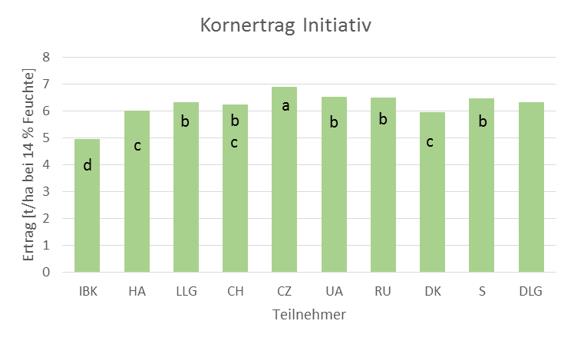
The classic of the DLG Field Days, the European Winter Wheat Cultivation Comparison, was again the meeting place for numerous visitors. This year nine professional colleagues took part, four from Germany and 5 others from Northern and Eastern European countries (Table 1). For the first time, this took place under the conditions of the amendment to the DVO, which prescribes an N fertiliser requirement analysis.
Some of the self-imposed goals were very ambitious, both in the category "Competition", in which the participant in the role of the local farmer is to manage particularly profitably, and in the category "Innovation", which serves to present new ideas in stock management.
The Strip Till method, which has been tried and tested in the "DLG System Comparison Tillage", was presented as an additional variant.
Weather and growth during the growing season
Temperatures in August and September and total precipitation were in line with the long-term average. More rain fell in October, but a dry and warm second decade allowed soil preparation and sowing under optimal conditions.
Sowing on 13 October was followed by a uniform emergence on 21 October with high field emergence rates between 85 and 100% (exceptions Durum (77%) and Strip Till (70%)).
October marked the beginning of a warmer than average period, which resulted in continuous vegetation until January (+2.8°C). It was not until February that wintry temperatures prevailed with the minimum at the turn of the month to March. The slow, steady cooling ensured good hardening of the plants, which survived the bare frost well. March was 2.7°C too cold compared to the long-term average. This shifted the start of vegetation into the first decade of April. The plants went from winter dormancy directly into the shooting phase. Further phenological development was greatly accelerated.
The transition to summer temperatures was abrupt. All months up to harvest were warmer than average with numerous temperature peaks above 30 degrees.
Up to and including April - despite monthly differences - precipitation in the normal range ensured a good water supply. The precipitation deficit from May onwards, in combination with the strong growth, quickly exhausted the soil water supply, so that from the end of May there was an extreme water shortage. This is particularly evident in the ear density, which almost consistently failed to reach the site-typical optimum, which in the Magdeburger Börde is 500 ears per square metre (Table 3).
Maturity began as early as mid-June, so that the precipitation in the second decade of July no longer had an effect on yield.
The trial was harvested on 27 July. With a marginal difference in the T-test of 0.32 t/ha, the precision of the trial can be classified as good.
Competition variants - the participant in the role of the local farmer
Grain yields and qualities
Table 3 compares the participants' original yield targets with the grain yields actually achieved (Table 2). The yield level has suffered due to the drought and corresponds to the conditions in the practical farms of the Magdeburger Börde, where about 30 % less than the long-term average was harvested.
Only four practices (IB, HA, UA and RU) achieved more than 70 % of their originally planned grain yield. Especially our northern neighbour and the Czech Republic were not able to realise their ambitious targets. But even a "local" and the otherwise heat-tested Swiss had their problems with the extreme conditions.
The 9 methods ARE TOTALLY assigned to % yield groups (Table 4). The IBK method has the highest yield. In the second group are the HA and UA methods with 6.62 and 6.61 t/ha respectively. In the third group, only LLG can be clearly distinguished, while CZ with 6.19 and 6.16 t/ha, CH and DK cannot be clearly assigned. S and RU form the fifth group.
In the IBK system, besides the top yield of 7.24 t/ha, the yield target was best met with 80 %. From 241 emerged plants, 421 productive ears per m² developed. In these, an average of 43 grains with a TKG of 39.8 produced the highest individual ear yield of 1.72 grams per ear.
At the other end of the scale, things do not look so clear. Here are four methods (CH, RU, DK and S) with practically equal yields based on different crop parameters (see table/figure 4).
The differences continue in grain quality (Table 3). The dry and very warm weather in the grain filling and ripening phase obviously hampered nitrogen uptake from the soil, which led, for example, in the IBK procedure to the protein content of the E-wheat not meeting the minimum requirements. Starch synthesis, which was also limited by lack of water, resulted in an unusually high protein content in other procedures (DK).
All participants adhered to the maximum nitrogen application specified by the fertiliser requirement calculation. But all procedures that deviated strongly from the target yield exceeded the balance surplus of 50 kg N/ha, in some cases significantly (in the initiative procedures, all procedures were below the 50 kg limit).
Direct cost-free performance
Higher qualities were not particularly rewarded by the trade because of the good harvest conditions this year (Table 3). The difference amounts to only 5 €/t. Thus, grain yield and direct costs are the decisive factors for the economic success of the methods. Table 5 shows the revenues and directly attributable costs of the methods.
Revenues vary significantly by 290 € between 1157 and 1447 €/ha. In contrast, the costs differ by only 155 € (567 - 722 €/ha). In combination, this results in differences in direct cost-free output of up to 397 €/ha (Table 5).
This makes the method of the Institute of Natural Resources and Applied Life Sciences the financial winner of the competition, closely followed by the Anhalt University of Applied Sciences. Ukraine and the Czech Republic follow in the next ranks. The methods from Russia, the Landesanstalt and Switzerland show little difference, while the methods of the colleagues from Sweden and Denmark suffer from particularly high direct costs with low yields.
Initiative variants - an experiment with unorthodox measures
The differences to the competition variants of the individual participants are sometimes considerable and offer some surprises. IBK, for example, chose a winter durum as an alternative to soft wheat cultivation in the Magdeburger Börde. LLG demonstrated side-dressing with a variant from its StaPlaRes project, whereby stabilised urea is slit into the existing wheat stand, while HA showed single application of stabilised urea in its fertiliser approach. CZ, CH and S tried differentiated fungicide strategies, while DK worked without growth regulator and RU raised seed strength in addition to another variety. UA showed its own variety with seed density lowered to local conditions. In total, 7 of the 9 participants chose a different variety than in the competition variant.
In grain yield, the CZ method was in the lead, the following methods did not show any significant differences (Table Figure 4). The DK method had to pay its tribute to the drought with 55 % to the target yield and the durum in the IBK method produced a lower yield due to the type.
Four methods (RU, CH, CZ and UA) show only minor differences in the direct cost-free performance at the top. In terms of performance, they rank just behind the top variants in the competition. But even in this division, the Scandinavian cultivation technology was not able to cope with the stresses of the drought. The possibility of achieving high yields with durum in the Magdeburger Börde could not be realised this year.
A variant of strip seeding (Strip Till) from the DLG trial field "Holstein" of the IPZ Bernburg was included in the programme. In this method, two rows of seed were sown in the cultivated strip and the area in between, which was not cultivated, remained free. This reduced the seed rate to half. The emergence rate remained clearly below average at 70 %. This can be attributed to the immediately previously loosened and not reconsolidated strip. This left 105 plants per m², which, however, formed 347 ears per m² with an enormous productive tillering of 3.3 ears per plant. TKG (40 g) and grain number/ear (46) also reached peak values with a high protein content (15.1 %). Here, the water was obviously enough to fill the grain. The method, which would be economically classified in the front midfield, thus qualifies for farms that already work with other crops in the Strip Till method and could thus completely convert the farm to this erosion-reducing method.
In the history of the Winter Wheat Crop Comparison since 1988, the task set for the participants with the separation into competition and initiative variants has been established in order to concentrate the determination and concentration of the participants in the competition variant. It was not uncommon that the "second" plot had the higher yield and was then desired by the participant as a competition entry. This year, too, the grain yields are higher in six of the nine participants in the initiative variant. The differences are even more evident in the contribution margins.
However, if the trial is viewed from a usual farm situation, in which the farm manager does not put all his eggs in one basket for reasons of risk reduction, but applies one of his methods in the farm in equal parts, the picture shown in Table 5 emerges. The differences in direct cost-free performance between the participants become smaller and the order changes. UA, CZ, HA and RU differ by a maximum of 40 €/ha. After that, IBK and CH are almost on a par. Only then, with some distance, come LLG and the two Scandinavian participants, who are used to a wetter environment and whose process design did not correspond to the extreme dry conditions.
Conclusion:
Under the extreme conditions of the 2018 harvest year, it was clearly demonstrated that good knowledge of the location and quick reaction to the weather are the keys to economic success. More than in previous years, the Eastern European participants were "ahead of the game" this time. Not necessarily in terms of yield, but then in terms of direct cost-free performance. This shows that we can learn a lot from these professional colleagues in preparation for the changing climate.
We would like to express our sincere thanks to all participants, because it was only through their courage to present themselves on the stage of the DLG Field Days that this interesting collection of different wheat cultivation methods in our field came about.
Further thanks are due to the scientific supporters, Professor Honermeier and Dr Büchse, who vouch for the technical soundness of the trial, and to the company FarmFacts, whose support made the documentation and publication of the DLG Field Days facts possible.
Dr. Reinhard Roßberg
Siv Ahlers
DLG e.V., Frankfurt am Main






